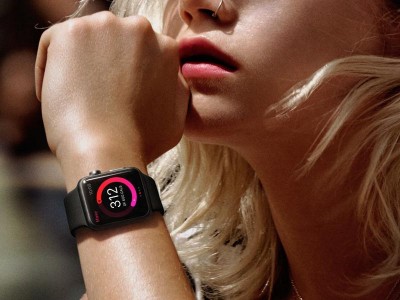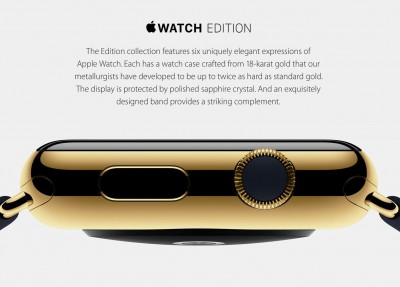Last week we told you about the overall negative reaction to Apple’s Apple Watch announcement. This is not to say that all reaction was critical, but on balance, there were more negative comments than favorable ones. As we predicted, there were three major points of contention about the Apple Watch: pricing, short battery life, and lack of need for this particular product.
If it was any other corporation in the world receiving this kind of negative coverage, it would likely be cause for some concern in their HQ. But this is Apple we’re talking about, and they didn’t get to be the world’s largest company by accident. Apple’s pre-eminence emerged not just because the company was able to deliver revolutionary new technologies. Apple sits at the top of the heap because they combined revolutionary products with revolutionary marketing initiatives that keep their products in high demand, whether there’s a need for them or not.
Apple Watch Is a Predatory Organism
 Analyst Robert Hetu from Gartner Research compared the Apple Watch to the invasive Kudzu vine, an Asian plant that finds deep water with carbohydrate-rich roots, where it grows its vines and leaves in triplicate in order to crowd out competitors. Hetu said that Apple put down deep roots by tapping consumers music collections with the iPod. Then they crowded out other smartphones when they introduced touch-screens in the iPhone.
Analyst Robert Hetu from Gartner Research compared the Apple Watch to the invasive Kudzu vine, an Asian plant that finds deep water with carbohydrate-rich roots, where it grows its vines and leaves in triplicate in order to crowd out competitors. Hetu said that Apple put down deep roots by tapping consumers music collections with the iPod. Then they crowded out other smartphones when they introduced touch-screens in the iPhone.
He argues that Apple Pay will be the function that crowds out other smartwatch competitors, allowing the Apple Watch to “further revolutionize how consumers are influenced to purchase and their paths to making purchases… Apple continues to find ways to connect and make itself indispensable to consumers.”
With Apple’s roots already secured deep into the strata of electronics lovers, the Apple Watch modus operandi is to branch out and drop seeds into previously uncultivated segments of the marketplace. The goal is to reach consumers beyond their core audience, in search of new converts to the Apple ecosystem.
Apple Watch Wants Android and BlackBerry Converts
Case-in-point: Apple is about to launch a new recycling and trade-in program that will accept Android and BlackBerry devices in exchange for gift cards to be used toward the purchase of new iPhones. The deal will begin in the next couple of weeks, which happens to be when the Apple Watch will begin to hit the shelves.
Of course, if you want a new Apple Watch, you’ll need the iPhone 5 or newer model to go along with it. So Apple has now given any Android user who’s become intoxicated by the Apple Watch buzz the opportunity to make the move over to Apple’s earthly paradise.
Marketing the Apple Watch is a cold and thoroughly calculated process. One simply gets the sense that there is no amount of nit-picking about battery life or pricing that is going to derail this freight train.
Apple Watch Wants Women Converts
Here is another example: Targeting the Apple Watch toward women. There can be no doubt that most of the early Apple Watch advertising is aimed not at tech geeks, but at women who value style. Here’s a 12-page advertising spread in Vogue Magazine, and over there is supermodel Candice Swanepoel modelling an Apple Watch in Self Magazine.
This is the genius of Apple, creating a market and a demand for their products where none existed before. In A Blog To Watch, Ariel Adams writes:
Female consumer acceptance of the Apple Watch is extremely important for the smartwatch industry who, until now, has mostly male buyers. Smartwatch companies have, for the most part, failed to convince women that smartwatches are useful, sexy, trendy, and aspirational. If anyone can remove the “geek element” from a connected wearable communications device, it is Apple, and they know it needs to be done right off-the-bat if the Apple Watch is going to be perceived as an object of desire for women.
Apple Watch Wants Luxury Converts
Some of the harshest criticisms directed towards the Apple Watch were generated by the inclusion of the $10,000 Gold Edition model. People scoffed at the prospect of spending so much money on a device that may be technologically obsolete in a year or two, as opposed to the great gold analog watches made in Switzerland.
 But Forbes Magazine argues that the solid-gold Apple Watch represents good strategy. They said that even the non-gold versions of the Apple Watch represent something of a luxury, since it doesn’t offer any must-have utility to the mainstream consumer. Therefore, by offering the high-end versions, Apple is reinforcing the luxury cachet of the entire Apple Watch franchise.
But Forbes Magazine argues that the solid-gold Apple Watch represents good strategy. They said that even the non-gold versions of the Apple Watch represent something of a luxury, since it doesn’t offer any must-have utility to the mainstream consumer. Therefore, by offering the high-end versions, Apple is reinforcing the luxury cachet of the entire Apple Watch franchise.
Furthermore, the gold edition will inevitably lead to a Apple Watch breakthrough in China, where the appetite for gold is stronger and the number of wealthy consumers is large. And since the amount of gold in the Edition model is only worth about $1,800, the Apple Watch will generate a tidy profit at the same time it generates aspirational value. That’s a marketing double-play.
We know that everybody likes to say they are not swayed by marketing and advertising. But is it possible that you too have fallen for Apple’s marketing masterstrokes over the years?
